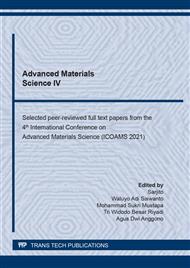[1]
M. Xue, Y. Ji, J. Ou, F. Wang, C. Li, S. Lei, W. Li, Surface wettability and strong adhesion of medical polyurethane elastomer porous films by microphase separation. AIP Advances 9 (2009) 075309.
DOI: 10.1063/1.5107459
Google Scholar
[2]
F. Awaja, M. Gilbert, G. Kelly, B. Fox, P.J. Pigram, Adhesion of polymers. Prog. Polym. Sci. 34 (2009) 948–968.
DOI: 10.1016/j.progpolymsci.2009.04.007
Google Scholar
[3]
A. Sarani, A.Y. Nikiforov, N.D. Geyter, R. Morent, C. Leys, Surface modification of polypropylene with an atmospheric pressure plasma jet sustained in argon and an argon/water vapour mixture. Appl. Surf. Sci. 257 (2011) 8737-8741.
DOI: 10.1016/j.apsusc.2011.05.071
Google Scholar
[4]
R.P. Guragain, S. Gautam, R. Shrestha, D.P. Subedi, Surface modification of polycarbonate by treatment with 50hz dielectric barrier discharge at near atmospheric pressure. International Journal of Science and Research, 5 (2016) 1468.
Google Scholar
[5]
C. Mandolfino, E. Lertora, C. Gambaro, M. Bruno, Improving adhesion performance of polyethylene surfaces by cold plasma treatment. Meccanica, 49 (2014) 2299–2306.
DOI: 10.1007/s11012-014-9993-y
Google Scholar
[6]
S. Van Vrekhem, P. Cools, H. Declercq, A. Van Tongel, C. Vercruysse, M. Cornelissen, N. De Geyter, R. Morent, Application of atmospheric pressure plasma on polyethylene for increased prosthesis adhesion. Thin Solid Films, 596 (2015) 256-263.
DOI: 10.1016/j.tsf.2015.08.055
Google Scholar
[7]
J. Turicek, N. Ratts, M. Kaltchev, N. Masoud, Surface treatment of ultra-high molecular weight polyethylene (UHMWPE) by cold atmospheric plasma (CAP) for biocompatibility enhancement, Appl. Sci. 11 (2021) 1703.
DOI: 10.3390/app11041703
Google Scholar
[8]
Z. Károly, G. Kalácska, J. Sukumaran, D. Fauconnier, Á. Kalácska, M. Mohai, S. Klébert, Effect of Atmospheric Cold Plasma Treatment on the Adhesion and Tribological Properties of Polyamide 66 and Poly(Tetrafluoroethylene). Materials, 12 (2019) 658.
DOI: 10.3390/ma12040658
Google Scholar
[9]
D.G. Petlin, S.I. Tverdokhlebov, Y.G. Anissimov, Plasma treatment as an efficient tool for controlled drug release from polymeric materials: A review. J Control Release. 28 (2017) 266:57-74.
DOI: 10.1016/j.jconrel.2017.09.023
Google Scholar
[10]
C. Ma, A. Nikiforov, N.De Geyter, X. Dai, R. Morent, K.K. Ostrikov. Future antiviral polymers by plasma processing. Prog Polym Sci. 118 (2021) 101410.
DOI: 10.1016/j.progpolymsci.2021.101410
Google Scholar
[11]
A. Vesel, G. Primc, Investigation of surface modification of polystyrene by a direct and remote atmospheric-pressure plasma jet treatment, Materials 13 (2020) 2435.
DOI: 10.3390/ma13112435
Google Scholar
[12]
P.K. Chu, J.K. Chen, L.P. Wang, N. Huang, Plasma-surface modification of biomaterials. Mater. Sci. Eng. 36 (2002) 143-206.
Google Scholar
[13]
A Fridman, A Chirokov, A Gutsol, Non-thermal atmospheric pressure discharges. J. Phys. D Appl. Phys. 38 (2005) 1-24.
DOI: 10.1088/0022-3727/38/2/r01
Google Scholar
[14]
K.G. Kostov, T.M.C. Nishim, A.H.R. Castro, A. Toth, , L.R.O. Hein, Surface modification of polymeric materials by cold atmospheric plasma jet. Appl. Surf. Sci. 314 (2014) 367–375.
DOI: 10.1016/j.apsusc.2014.07.009
Google Scholar
[15]
D. Shaw, A. West, J. Bredin, E. Wagenaars, Mechanisms behind surface modification of polypropylene film using an atmospheric-pressure plasma jet. Plasma Sources Sci. Technol. 25 (2016) 065018.
DOI: 10.1088/0963-0252/25/6/065018
Google Scholar
[16]
M. Noeske, J. Degenhardt, S. Strudthoff, U. Lommatzsch, Plasma jet treatment of five polymers at atmospheric pressure: surface modifications and the relevance for adhesion, Int J Adhes Adhes. 24 (2004) 171–177.
DOI: 10.1016/j.ijadhadh.2003.09.006
Google Scholar
[17]
W-S. Kim, I-H. Yun, J-J. Lee, H-T. Jung, Evaluation of mechanical interlock effect on adhesion strength of polymer-metal interfaces using micro-patterned surface topography, Int J Adhes Adhes. 30 (2010) 408-417.
DOI: 10.1016/j.ijadhadh.2010.05.004
Google Scholar
[18]
H.B. Baniya, M.B. Kshetri, R. Shrestha, B.P. Pandey, R.P. Guragain, D.P. Subedi, Generation and characterization of an atmospheric-pressure plasma jet (appj) and its application in the surface modification of polyethylene terephthalate, Int. J. Polym. Sci. 2020 (2020) 9247642.
DOI: 10.1155/2020/9247642
Google Scholar
[19]
L. Manaloto-Ceballos, W. Labriaga, S-Y. Song, J-H Park, Nonthermal plasma on the shear bond strength of relining resin to thermoplastic denture base resin. J Korean Acad Prosthodont. 56 (2018) 199.
DOI: 10.4047/jkap.2018.56.3.199
Google Scholar
[20]
D. Hegemann, H. Brunner, C. Oehr, Plasma treatment of polymers for surface and adhesion improvement. Nucl. Instrum. Methods Phys. Res. B: Beam Interactions with Materials and Atoms, 208 (2003) 281-286.
DOI: 10.1016/s0168-583x(03)00644-x
Google Scholar
[21]
R. Thompson, D. Austin, C. Wang, A. Neville, L. Lin, Low-frequency plasma activation of nylon 6, Appl. Surf. Sci. 544 (2021) 148929.
DOI: 10.1016/j.apsusc.2021.148929
Google Scholar
[22]
R. Tivony, Y. Zhang, J. Klein, Modulating interfacial energy dissipation via potential-controlled ion trapping. J. Phys. Chem. C. 125 (2021) 3616–3622.
DOI: 10.1021/acs.jpcc.0c11264
Google Scholar
[23]
J. Krim, Surface science and the atomic-scale origins of friction: what once was old is new again. Surf. Sci. 500 (2002) 741-758.
DOI: 10.1016/s0039-6028(01)01529-1
Google Scholar
[24]
D.J. Wolthuizen, D. Martinez-Martinez, Y.T. Pei, Influence of plasma treatments on the frictional performance of rubbers. Tribol Lett 47 (2012) 303–311.
DOI: 10.1007/s11249-012-9985-9
Google Scholar


